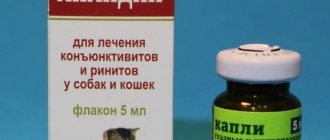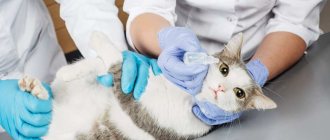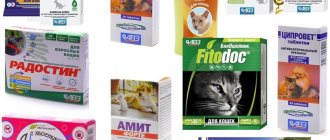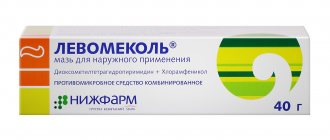Mode of application
The dosage of the medicine and the duration of its use depend on the purpose of use:
- Prophylactic dose – 1 drop 4 times a day for 3 days. For some cats, 1 drop twice a day is enough. The frequency is selected individually by a specialist, depending on the health and age of the animal.
- Treatment of eye pathologies lasts from 7 to 10 days. Cats need eye drops 4 times a day, a single dosage is 1 drop, regardless of the pet’s weight.
- For inflammatory processes caused by foreign objects, Iris is given 1 drop four times a day.
The veterinary product has a prolonged effect, but procedures should not be skipped - eye drops, like most medications, give a cumulative result.
It is recommended to apply them at regular intervals, ideally at the same time. It is not recommended to interrupt the course, but if a day is missed for objective reasons, it is advisable to urgently resume treatment. Dosages are the same as before the break.
No special reactions to the solution were identified, but individual intolerance to one or more components cannot be excluded. If your cat's eyes are red or very watery, or purulent discharge appears, you should consult a clinic.
The owner should know how to properly instill the drug into a pet:
- First, you need to wipe your eyes, eyelids and the area under the eyes with a cotton swab, previously soaked in a special pharmaceutical solution. It can be replaced with herbal decoction or boiled water.
- The crust, dried secretions and growths are removed gradually - first you need to soak them.
- It is better for two people to put drops in a cat’s eyes: one holds the animal, the other administers the drug. The composition should get into the area of the lower eyelid - to do this you will have to pull it off with your fingers and hold it.
- Immediately after the administration of Iris, there may be redness and burning - a short-term reaction to an external irritant. You should not allow your cat to scratch its eyes - the drug will not work.
- The drops take effect within 3-5 minutes. All this time, the owners need to calm the animal by stroking it and stop attempts to escape.
- Afterwards, be sure to wash your hands.
Mode of application
Before using Iris drops for a cat, you need to make sure there are no contraindications.
The dosage and course of use should be prescribed by a veterinarian, at least by phone. Otherwise, you can harm the cat without curing the eye disease.
When treating pathologies, it is very important to be able to correctly administer Iris drops to a cat.
A piece of cotton wool should be moistened in a decoction of herbs, boiled water or medicine and wipe the eyes and the area around them.
All crusts and growths must be removed gradually, allowing them to soften a little first. You need to take the drops in one hand and push the cat’s lower eyelid down with the other. After this, you can drop 3-5 drops of Iris into the affected eye. The animal may begin to break free, but it is very important not to let go of it for 3-5 minutes and allow the drug to work. At this time, the animal may experience redness of the eyes, itching and tearing.
But this is only a temporary local reaction to the stimulus, which passes very quickly. The animal's attempts to scratch its eyes must be stopped. After the specified time has passed, the cat needs to be calmed down by simply stroking it gently. Then remove the purulent discharge that appears and drip another 1-2 drops. The procedure should be repeated 3-4 times a day for a week. Hands should be washed with soap after the procedure.
If Iris is used for preventive purposes, then its dose should be reduced to 1 drop twice a day.
It is not recommended to interrupt the course of treatment with the drug. If such a situation does occur, then it should be resumed urgently in the previously indicated dosages.
shutterstock
If an allergic reaction occurs in a cat, you should immediately go to a medical facility, taking with you a bottle of the product or a box of it.
What precautions should owners take?
When using drops, you need to remember personal hygiene and safety standards. When instilling the product into the eyes of an animal, the owner is prohibited from eating or smoking. After completing the procedure, hands should be washed thoroughly with warm water and soap.
People with individual intolerance to the components included in the drug should avoid direct interaction with it. If allergic reactions occur, you should immediately contact a medical facility. If the medicine gets on the surface of the epidermis and mucous membranes, the affected area is washed well with water. An empty bottle left over from Iris eye drops cannot be used for household purposes. The packaging should be thrown away.
How to use the drug correctly?
With the development of acute ailments that manifest themselves in the form of a purulent inflammation process, the affected organ of vision is washed before using the product. To do this, use tea leaves or medicine prescribed by the doctor. The discharge is carefully removed using a gauze pad. Then two drops of the drug are administered. The procedure is repeated three to four times a day. The frequency of its implementation is determined by a specialist, it all depends on the severity of the disease and the condition of the animal. The course of therapy varies from seven to ten days. A single dosage of Iris (eye drops for dogs) is determined by a veterinarian. It depends on the body weight of the animals. Larger pets require a larger amount of the drug.
If dogs weigh less than 10 kilograms, one drop is enough for them. If it exceeds this value, the dose is doubled.
For preventive purposes, the drug is used three times a day. The course of application is no more than 3 days. The required amount of product for one-time use is 1 drop.
Eye drops “Iris” for cats and dogs have practically no contraindications and do not have a negative effect on the animal’s body. However, some pets experience symptoms of individual intolerance to the components included in the product. In such cases, the medication should be replaced with another medicine.
Description of the drug
The drug in the bottle looks like a yellowish solution without sediment.
© shutterstock
The product contains gentamicin sulfate, which effectively fights most pathogenic bacteria. The exceptions are their anaerobic varieties, viruses and protozoa.
Thanks to the optimal ratio of salts in the drug, it perfectly treats the cat’s eyes and maintains the positive effect for a long time.
Contraindications to the use of this product are individual intolerance to the components of the drug or pregnancy of the cat.
Iris is a low-hazard substance; no cases of side effects have been identified.
Iris, eye drops, fl. 10 ml
COMPOSITION AND RELEASE FORM Eye drops IRIS is an antibacterial drug containing gentamicin sulfate (0.4%) as an active ingredient, as well as auxiliary components: technical sodium pyrosulfite, disodium ethylenediamine tetraacetic acid, medium molecular weight polyvinylpyrrolidone, water for injections. The drug is a clear, light yellow liquid. IRIS eye drops are produced packaged in 10 ml polymer dropper bottles. PHARMACOLOGICAL PROPERTIES IRIS eye drops have pronounced antibacterial and anti-inflammatory properties. Gentamicin sulfate, which is part of the drug, has a bactericidal effect on many gram-positive and gram-negative bacteria, including Pseudomonas aeruginosa. Does not affect anaerobic bacteria, fungi, viruses and protozoa. The mechanism of action of the antibiotic is based on inhibition of peptide bonds during protein synthesis in the ribosomes of the bacterial cell. When drops are instilled into the conjunctival cavity of the diseased eye, the drug easily penetrates through the cornea into the intraocular media, which ensures a stable therapeutic concentration of gentamicin sulfate inside the eye. ORDER OF APPLICATION IRIS eye drops are prescribed to dogs and cats for therapeutic and prophylactic purposes for acute and chronic conjunctivitis, keratitis, keratoconjunctivitis, ulcers and erosions of the cornea, meibomyitis, blepharitis and iridocyclitis (uveitis). For therapeutic purposes, the drug is instilled into the conjunctival cavity 4 times a day, for 7-10 days in doses: dogs weighing up to 10 kg 1 drop, 10 kg or more - 2 drops, cats regardless of body weight - 1 drop . To prevent complications when a foreign body or other irritating agents gets into the eye, the drug is instilled into the animal’s conjunctival cavity, 1 drop 4 times a day for 3 days. SIDE EFFECTS There are, as a rule, no side effects or complications when using IRIS eye drops in accordance with these instructions. In case of increased individual sensitivity of the animal to the components of the drug and signs of severe irritation, the use of IRIS eye drops is discontinued. SPECIAL INSTRUCTIONS When working with IRIS eye drops, you should follow the general rules of personal hygiene and safety precautions provided for when working with medicinal products for animals. IRIS eye drops should not be used after the expiration date.
STORAGE CONDITIONS Store the medicine with precautions (list B) in the original packaging, in a cool place, protected from light and moisture, separately from food and feed. The shelf life of the drug, subject to storage conditions in closed original packaging, is 2 years from the date of manufacture, after opening the bottle - no more than 10 days
IRIS eye drops should be stored out of the reach of children and animals.
general information
Iris eye drops are produced by the scientific implementation center Agrovetzashchita, a leading developer and manufacturer of veterinary drugs in Russia. Externally, it is a transparent yellowish liquid, packaged in soft plastic bottles with dropper caps of 10 ml.
The solution contains one active ingredient - gentamicin, 4 mg per milliliter.
Iris is stored in a closed factory bottle in a dark, dry place at 18 - 20℃. Shelf life – 36 months. The opened medicine can be used for a maximum of 10 days. Unused remains are thrown away.
Iris is freely sold in veterinary pharmacies, the price of a bottle is 170 - 200 rubles.
Recommended medications: which drops are best to choose?
Features of the drug "Iris"
In case of conjunctivitis in cats, the drug Iris is used, but only after consultation with a doctor.
These are the best medications for conjunctivitis that occurs in cats in the acute or chronic phase. Eye drops are used to treat other pathological conditions of the visual organs, namely such as:
- blepharitis;
- barley;
- septic type ulcer on the cornea.
These are antibiotics that contain gentamicin sulfate. Eye medicine must be used strictly as prescribed by a veterinarian. The action of the medication is aimed at combating the infectious focus in the outer area of the eye. It is possible to use eye drops for mechanical damage to the mucous membrane. Since the medicinal liquid is placed in a dropper bottle, the owner can easily put drops in the cat’s eyes.
"Levomycetin": what is remarkable?
Part of the group of antibacterial cat eye drops. Such drugs are prescribed for conjunctivitis, blepharitis and keratitis. "Levomycetin" can be used for prophylactic purposes to prevent postoperative complications and serious pathologies of the visual organs. The product suppresses the activity of pathogenic microorganisms on the cat’s mucosa.
When is Bars recommended?
Most often, veterinarians recommend putting these drops in your pet’s eyes. 2 drops are required to be injected into each visual organ, and the manipulation is repeated once a day. The drug "Bars" is indicated in the following cases:
- treatment and prevention of inflammation of the conjunctival membrane;
- prevention of infectious diseases due to injury to the eye structures.
"Diamond Eyes"
Severe lacrimation and inflammatory processes are relieved with Diamond Eyes.
Like Vizin, Taufon and other eye drops, this drug helps reduce the inflammatory reaction in the pet’s visual organs. The therapeutic effect is achieved due to the neutralization of pathogenic microflora. The medication can be used for daily hygiene in cats, as well as for the following disorders:
- excessive production of tears;
- inflammatory reaction;
- redness of the white of the eye;
- acute and chronic manifestations of conjunctivitis.
Application of "Anandin"
Good anti-inflammatory, antiviral and regenerating eye drops for kittens and adult cats, which contain glucaminepropylcarbacridone. The drug is used for inflammation of the conjunctiva and rhinitis. As a rule, during treatment, a dosage of 2 drops is adhered to, but it is worth contacting a veterinarian, who, if necessary, will adjust the dose individually for each cat.
"Tsiprovet": the effectiveness of drops
The active component of the veterinary drug is ciprofloxacin, which has an anti-inflammatory and bactericidal effect on the cat’s eye structures. Prescribed for eye diseases caused by the following pathogenic microorganisms:
- Pseudomonas aeruginosa;
- chlamydia;
- staphylococcus
In what cases is Barrier indicated?
For fungal infections, as well as in the postoperative period, the use of Barrier drops is indicated.
Veterinarians advise using similar eye medications, which have a complex effect. It is worth dripping a cat’s eyes for the following disorders:
- inflammatory reaction of the mucous membrane;
- infection by fungi and bacteria;
- infectious focus;
- postoperative period.
Types of eye diseases in cats
Cats can suffer from several types of eye problems.
Inflammatory eye diseases
Inflammatory diseases are caused by infections, injuries, hypothermia, allergies, and pathologies of the endocrine system.
The eyelids can become inflamed - such diseases include conjunctivitis and blepharitis. The mucous membranes of the eyelid swell and turn red, sometimes they can turn outward. In this case, purulent discharge from the eyes and profuse lacrimation are observed. With dry keratoconjunctivitis, on the contrary, the lacrimal glands cease to secrete the required amount of moisture.
The first symptom is often redness of the eyelids
Sometimes the cornea itself becomes inflamed - for example, with keratitis. Symptoms include watery eyes and squinting. The cornea becomes matte and shines unnaturally. Dark or cloudy spots and purulent discharge may appear.
Corneal injuries
A cat's eyes can be damaged during a fight, from bruising or being hit by a foreign object. This is not only dangerous in itself, but also leads to the penetration of pathogenic microorganisms into tissues.
Excessive lacrimation
Increased production of tears without signs of inflammation may be a symptom of the following problems:
- narrowing of the eye canal;
- allergy;
- cold;
- parasite infection.
Some breeds are naturally prone to excessive tearing.
Excessive tearing may be a symptom of parasite infestation
Other problems
Among other things, your pet may suffer from the following diseases:
- Turn of the century. In this case, the eye is irritated by the eyelashes pressing against it. The problem can only be solved surgically.
- Glaucoma. Increased pressure inside the eye. Accompanied by swelling of the eyelids and clouding of the cornea.
- Cataract. Cataract. It is more often observed in cats over 7 years of age.
- Prolapse of the eyeball when it comes out of the shaved area and is completely or partially outside the eyelids. Requires immediate veterinary attention.
Indications: when are feline medications used?
Pets are required to put drops into their eyes on the recommendation of a veterinarian. Medicines have a complex effect and relieve inflammation, restore mucous membranes, relieve swelling and stabilize vision. It is recommended for old and young cats to use “Vizin”, “Taufon”, “Iris”, “Barrier” and other eye drops for the following pathologies:
- infection or the appearance of an inflamed lesion;
- conjunctivitis and keratoconjunctivitis;
- keratitis;
- ulcerative formation on the cornea;
- blepharitis of the eyes;
- entry of a foreign body;
- postoperative period.
Decta-2 ophthalmic solution is not used for ailments caused by a viral infection. Eye drops "Dekta-2" and other similar veterinary drugs are not effective against pathologies caused by viruses, chlamydia, and mycoplasmas. Most products of this form are safe and do not harm the cat’s health. If, after using the drops, your pet exhibits adverse reactions, then the treatment is canceled and contact a veterinary clinic.
Characteristics of Iris eye drops for cats
Composition and release form
Iris drops are produced by the domestic Research and Development Plant (AVZ), founded in 1993. The drug is available in 10 ml plastic bottles with a dropper, packed in a cardboard box. It also contains detailed instructions for use.
The active ingredient is gentamicin sulfate (0.4%) - an antibiotic that actively affects many types of gram-positive and gram-negative microorganisms. It penetrates the bacterial cell membrane, changes the structure of the cell's ribosomes, which leads to disruption of the microorganism's protein synthesis and its death. The composition also includes a prolongator (increases the duration of action of the active component) and other excipients. The drug is instilled into the conjunctival sac, it is absorbed by the mucous membrane and penetrates the internal tissues of the eye, providing a local therapeutic effect.
Iris drops are used to treat eye diseases in cats and dogs
Indications for use
Iris is an ophthalmic veterinary remedy. It has a bactericidal, anti-inflammatory and regenerating effect, and is used in the treatment of many inflammatory eye diseases:
- conjunctivitis;
- keratitis;
- keratoconjunctivitis;
- ulcers and erosions;
- meibomyitis;
- blepharitis;
- uveitis.
The drug does not affect some types of microorganisms, these include:
- anaerobic bacteria;
- mushrooms;
- viruses;
- protozoa.
Iris drops are the first aid for injuries to the organs of vision, as they protect the body from the development of many types of pathogenic infections.
Directions for use, dosage and side effects
The dosage for cats of the drug Iris is one drop into the conjunctival cavity four times a day. This rate of drug administration is presented in its description on the page of the official website of the AVZ company. The instruction leaflet dated 05/11/2012 states one drop three times a day.
Depending on the purpose, different durations of use are suggested:
- for the treatment of inflammatory processes, therapy is carried out for 1–1.5 weeks;
- as a prophylactic for minor eye injuries or foreign body penetration - three days is enough.
Ophthalmological diseases can have complications with negative consequences (not only blindness, but also death). Treatment is recommended to be carried out under the supervision of a doctor. To properly instill the medicine, the cat's lower eyelid is slightly pulled outward, simply stretching the skin under it with a finger, then the solution is dripped and the eye is lightly stroked. The procedure is performed with an assistant.
Video: how to put drops in a cat’s eyes
Contraindications and side effects when using Iris drops
The instructions indicate that no side effects are observed when the dosage of the drug is taken exactly. Only an allergic reaction is possible if there is intolerance to certain components of the drug. However, the administration of gentamicin sulfate has a negative effect on the functioning of some organs:
- kidney;
- hearing organs;
- vestibular apparatus.
It is not recommended for use during pregnancy and lactation.
Neurotoxic or nephrotoxic drugs, as well as furosimide, ethacrynic acid and hydrocartisone, should not be administered simultaneously with gentamicin. It is incompatible with beta-lactam antibiotics, heparins, and amphotericin.
All these restrictions apply to a greater extent to the intramuscular administration of gentamicin. When used topically to treat eye tissue, it does not have a significant effect on the body.
If symptoms of overdose appear, the use of the medication should be discontinued. These signs include:
- vomit;
- anemia;
- drowsiness;
- tremor.
In severe cases, you need to contact a veterinary clinic. To quickly remove gentamicin from the body, hemodialysis is recommended.
The drug is stored in a dry and dark place, separate from feed and food. Children and animals should not have free access to it. Temperature range: from +5 to +25 °C. When the packaging is hermetically sealed, the manufacturer guarantees that the properties of the veterinary product will be preserved for 3 years from the date of release. After opening the bottle, Iris can be used for no more than ten days.
Composition and expiration date
The drug has a therapeutic effect due to the active substance included in its composition - gentamicin sulfate . Additional components enhance the effect of the drug - , etc. The solution is packaged in 10 ml dropper bottles.
Iris drops retain their medicinal properties for 3 years from the release date indicated on the package. But this applies to unopened bottles. As soon as the drops are started to be used, the shelf life is reduced to 10 days.
To ensure the preservation of pharmacological properties, it is necessary to properly store the medicine . The ambient temperature should not exceed +20°C and fall below +18°C. The storage location must be dry and protected from daylight.
Features of the drug's action
Iris eye drops, penetrating into the conjunctival cavity, are completely absorbed by the connective membrane. They then enter the cornea area. Due to the special composition and texture of the drug, it is evenly distributed throughout all cells of the visual organs. Drops destroy pathogens during infection. In addition, they have a positive effect on the condition of the cornea and connective membrane, as well as the internal structures of the eyes. The drug is used not only as a means of therapy.
It is also used as a prophylaxis against deterioration of the condition after suffering ophthalmological pathologies. In what cases do veterinarians recommend using Iris eye drops? This is covered in the next section.
Reviews
Fragments of reviews about Iris eye drops from the sites otzovik.com and irecommend.ru:
- We stopped the spread of infection after an injury to a dog.
- Acute conjunctivitis in a Chihuahua was cured.
- Prevented the development of keratitis and uveitis after blunt eye trauma in a cat.
- We dealt with excess tearing in a Yorkie.
- They did not help get rid of the tear tracks in the Chinese Crested Dog.
Iris drops are an effective, budget-friendly, affordable drug for eye diseases in dogs and cats. The medicine destroys the causative agents of bacterial infections, is well tolerated and rarely causes side symptoms. Watch the video on how to properly administer eye drops to your dog.
Indications for use
The drops penetrate perfectly into the intraocular environment, which ensures the effectiveness of the drug anywhere in the eyeball. Thanks to this property, the product is applicable in the fight against many eye diseases and deep mechanical damage.
shutterstock
Iris drops can be used for cats and dogs in the following situations:
- chronic or acute conjunctivitis, accompanied by purulent discharge from the eyes;
- keratoconjunctivitis;
- keratitis;
- uveitis;
- a thorn that has arisen as an infection penetrates into the visual organ;
- an allergic reaction to chemicals, foods, medications, which is expressed by swelling of the eyelids;
- ulcers and erosions of the cornea;
- meibomitis;
- septic iridocyclitis;
- blepharitis.
Mechanical traumatic damage to the eyeball can also be a reason for prescribing Iris. In addition, it is recommended for use before and after surgery.
If redness, tearing and purulent discharge from the eyes are detected, you should immediately rinse the cat's eyes and then instill drops. Only after completing this procedure can you go for an examination.
Pathologies for which the drug should be used
The drug is used to treat the following ailments:
- Inflammatory processes in the cornea and connective membrane of the eyes.
- Blepharitis.
- Dacryocystitis.
- Ulcers on the surface of the cornea.
- Mechanical damage to the eyeball and tissues close to it.
- Inflammatory process in the choroid.
- Other types of eye infections.
It is advisable to consult a veterinarian before starting therapy with Ir is. Eye drops according to the instructions are used in different dosages depending on the type of pathology and condition of the animal.
Analogs of Iris eye drops
Below are solutions with similar pharmacological effects and brief recommendations for their use:
- Bars (AVZ). Main component: chloramphenicol - 0.25%; furatsilin - 0.02%. Has a slight anesthetic effect. For hygiene and prevention, once a day the eyes are treated with a sterile cotton swab moistened with this solution. When treating inflammatory pathologies, one or two drops are instilled three times a day (after cleaning the eye and surrounding area). Apply for a course of 7 – 14 days. The course of treatment may be repeated. Available in ten ml bottles. Price 151-200 rubles.
- Tsiprovet (AVZ). Composition: ciprofloxacin hydrochloride 0.45%. Used for preventive purposes before and after surgery. Dosage: one drop four times a day for one to two weeks, until final convalescence. If there is discharge, hygienic treatment with tsiprovet is mandatory. Release form: 10 ml bottles. The drug costs 166 – 219 rubles.
- Anandin (Meditar LLC, St. Petersburg). Active agent: anandin 2%. Used in eye traumatology as a stimulator of regenerative processes. In addition to its use in ophthalmology, it is applicable in the treatment of rhinitis. To treat eye pathologies, instill 2 drops twice a day until complete healing. Duration of use should not exceed two weeks. Available in 5 ml bottles. Price 70-98 rubles.
- Desacid (JSC Agrobioprom). Main components: gentamicin sulfate 0.4%, succinic acid - 0.1%, royal jelly - 0.05%. The drug normalizes intraocular pressure, prevents corneal pathologies, and is used in the treatment of dermatitis of the periorbital area. Before use, the solution must be mixed by shaking the bottle repeatedly. Treatment is carried out with a sterile swab soaked in Desacid. Cats: 1 drop three times a day for five to ten days. To prevent inflammation of traumatic lesions, use 1 drop four times a day for three days in a row. In the treatment of dermatitis, the substance is applied to the affected area three times a day until complete recovery. Available in ten ml bottles. Price 168-190 rubles.
- Diamond eyes (AVZ). Ingredients: taurine - 2%, succinic acid - 0.1%, chlorhexidine bigluconate - 0.15%, purified water. The drug prevents the development of cataracts and dystrophic changes in the retina (retina) and lens. If the inflammation is minor, there is an injury or severe lacrimation, one drop is prescribed three times a day, after hygiene of the eye and the surrounding area (if necessary). Duration of use is no more than two weeks, then, if necessary, repeat after five days. For preventive purposes (cataracts, age-related changes in the eye), use one drop twice a day for 20 days, then a ten-day break is necessary. Release form: 10 ml bottles. Price from 174 to 229 rubles.
- Dekta-2 (API-SAN LLC). Main components: gentamicin sulfate - 0.5%, dexamethasone sodium phosphate - 0.1%. It has an antiallergic effect and is used after surgical procedures. For treatment, use 2-3 drops several times a day for a course of 5-10 days, for prophylaxis - 1-2 drops 3 times a day for a course of 3 days. Release form: 5 ml bottles. Price from 115 to 154 rubles.
- Lakrikan (JSC “Top-Vet”). Contains: polysept - 0.02%, anesthesin - 0.002%, menthol - 0.005%. The drug is characterized by local anesthetic, enveloping and deodorizing properties. Normalizes tear separation. Used for eye hygiene procedures and treatment of bacterial inflammation. Treatment: 1 drop 3 times a day for 9 days in a row. Bottles of 10 ml. Price: 56 – 63 rubles.
Analogs
If you are intolerant to Iris drops, your veterinarian may recommend analogue drugs:
- Tsiprovet. The cost of a 10 ml bottle is about 160 rubles. The active ingredient is ciprofloxacin hydrochloride. Compared to the drug Iris, Tsiprovet has fewer indications for use.
- Desacid. Contains several active components, including gentamicin sulfate, and therefore has a wider spectrum of action. The cost of a 10 ml bottle is about 180 rubles.
- Anandin. The cost of the drops is about 70 rubles. per bottle 5 ml. The drug is good because it not only fights inflammation, but promotes tissue regeneration.
Iris eye drops are an effective remedy. It is safe for dogs, but it is not recommended to use the medicine without consulting a veterinarian.
How to put drops in a cat's eyes
Medicines are instilled directly into the animal's eyes. First of all, try to calm the cat down. Place her on your lap, pet her, talk quietly and calmly
If the animal behaves nervously and aggressively, you can carefully wrap it in a towel
If there is purulent or mucous discharge on the eyes, clean them with a cotton pad soaked in lotion.
Then place one palm on the cat's head, lift it up and use your fingers to open the eyelid. Place one drop and allow your pet to close the eye to distribute the product. Another way is to squeeze a few drops of the drug into the corner of a closed eye, then open the cat’s eyelids.
Repeat the procedure if necessary. At the end, praise your cat and give her a rewarding treat.
The break between instilling different types of drops should be at least 20 minutes.
Hygienic lotions are not instilled, but applied to a cotton pad or napkin, after which they wipe the cat’s eyes from the inner corner to the outer.
Please note that a number of hygiene products can cause staining or discoloration of the fur around the eyes, which is especially undesirable for show animals. In addition to special products, you can use strong black tea or saline solution to clean your eyes.
In addition to special products, you can use strong black tea or saline solution to clean your eyes.
Chamomile decoction is not recommended. One day, my relatives’ Persian cat began to “cry” more than usual, and they tried to solve the problem with chamomile - but after that, in addition to profuse lacrimation, baldness of the area around the eyes was added. The relatives were frightened, suspecting a skin disease, but, as the veterinarian explained, the cause was precisely the decoction - the substances contained in chamomile, when applied externally, lead to hair loss.
Most cats have their eyes cleaned once a day in the morning. For breeds with a natural tendency to tear, such as Persians or Britons, this procedure may be required more often, up to 2-3 times a day.
Indications and contraindications for use
The use of this remedy - a drug for the treatment of diseases of the organs of vision - is recommended for the penetration of pathogenic microorganisms into the eyes, acute and chronic forms of conjunctivitis, keratitis, meibomitis, ulcers and erosions of the cornea, uveitis, blepharitis, keratoconjunctivitis. Can be used to prevent complications after suffering ophthalmological pathologies. It is used for mechanical damage to the eyes, foreign bodies and small debris entering the organs of vision.
The use of the drug is prohibited if the pet is hypersensitive to the components. If the cat is pregnant, you should also stop using these drops and choose another medicine. Before use, consult a veterinarian and read the instructions for the drops.
Side effects are rare. Irritation may occur upon first use. If this happens, you should stop using the drug and contact your veterinarian.
Main indications
Iris is prescribed for the treatment of bacterial eye infections:
- Conjunctivitis is an acute or chronic inflammation of the mucous membrane of the eyes and eyelids.
- Keratitis is a lesion of the cornea.
- Keratoconjunctivitis is a combination of inflammation of the cornea and mucous membrane.
- Blepharitis is an infection of the eyelid margin.
- Dacryocystitis is inflammation of the lacrimal sac.
- Meibomitis is a lesion of the meibomian glands in the thickness of the eyelids.
- Ulcer, corneal erosion - destruction of the cornea after injury or harmful effects of infectious agents.
- Iridocyclitis is an inflammation of the iris and anterior choroid.
Drops help avoid complications after mechanical eye damage:
- injury, burn;
- removing specks;
- microsurgical operation;
- irritation from household chemicals.
Iris is included in the treatment regimen for viral and fungal infections, allergic conjunctivitis, and dry eye syndrome to prevent secondary bacterial infections.











